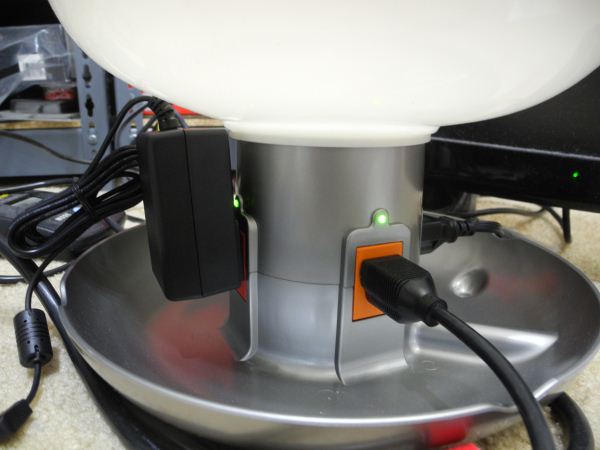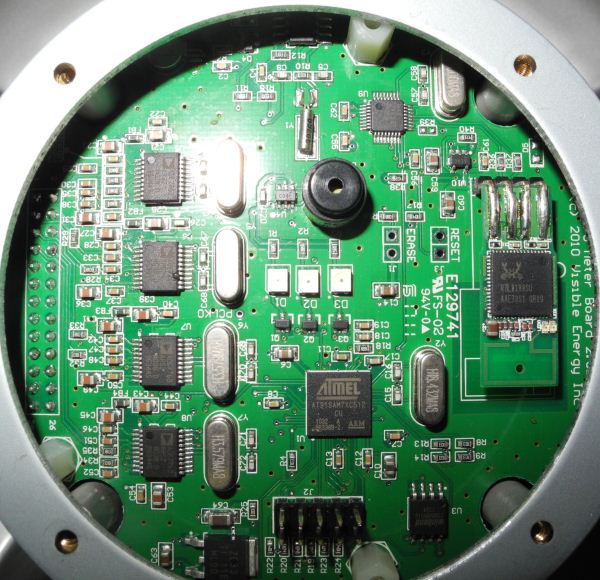Visible Energy UFO Power Center Smart Power Strip Review
by Ganesh T S on October 26, 2012 8:00 AM EST- Posted in
- Home Automation
- Wi-Fi
- Visible Energy
Hardware and Industrial Design
The industrial design of the UFO Power Center is definitely eye-catching, and may make for a good fit in some entertainment centers. Due to the non-standard design, it is sure to elicit polarizing opinions. Unfortunately, we are not great fans of the current size and shape of the unit. With a diameter of 12” and a height of 5”, it is too big to fit in most places where space is at a premium.
In addition, the clearance above and below the receptacles is not large enough for some ‘wall wart’ adapters, as shown in the photograph below (The adapter belongs to the Iomega EZ network attached hard disk). It is not possible to install the adapter with the output wire pointing downwards. Keeping the output wire pointed upwards (as shown below) makes it impossible to close the dome without dislodging the precariously positioned adapter from the receptacle.
Visible Energy has a blog post explaining the reason behind the size of the unit, and we will leave it to the reader to be the final judge.
Most of us are interested in the internals of the unit. Disassembling the unit exposed the following main components:
- 4x Schrack RT314F05 power relays, each of which is rated for 250V / 16A
- TI ULN2803A for switching the relay
- TNY278GN power switcher
- 4x ADE7763 energy metering ICs
- Atmel AT91SAM7XC512-CU microcontroller
- Realtek RTL8188SU 802.11b/g/n 1T1R WLAN Controller with USB 2.0 Interface
Despite being equipped with four relays capable of handling 16A each, Visible Energy has decided to play it safe by rating the whole unit for a maximum of 15A only.
A number of Wi-Fi companies (including TI, Qualcomm - Atheros and Marvell) have recently introduced a low cost system integrating the Wi-Fi radio and a MCU. Visible Energy currently uses two distinct chips for this, one from Atmel and the other from Realtek. The big vendors require complicated NDAs and large upfront payments. Given the projected low volume nature of the UFO Power Center (after all, it is Visible Energy’s first product) we actually need to applaud the company for choosing off-the-shelf components and making the entry price acceptable.
The Atmel microcontroller coordinates the operation of the unit as it sets up the ADE7763 chips for energy and power measurement. Power usage is computed and updated every second, while the energy usage is continuously monitored, but gets stored out once every five minutes. It also responds to the network requests from the Wi-Fi chip and sends back the requested data or modifies the relay status as applicable. The microcontroller also phones back home (to service.visiblenergy.com) with the energy / power data and socket status while also fetching any actions to be completed. These actions may have been set up by the user over the cloud interface. This pull mechanism enables control over the Internet without opening up any ports in the router for the unit. The downside is the fact that any change made to the socket status over the Internet could potentially take up to a minute to get reflected in the unit. Over the local network (for the iOS app / custom scripts using the open APIs), this is not a problem.
In addition, there are a number of other components such as a dedicated RTC (real time clock) and 1 MB of Flash memory for storage of energy history. This allows storage of the energy history of each socket for the previous 2 months at the minimum.
The LEDs and the Wi-Fi radio / miscellaneous board components contribute to a total power consumption of around 2.2 W even when nothing is connected to the sockets. By turning off the LEDs and the relays, it is possible to bring down the power to around 1.5 W.













35 Comments
View All Comments
DukeN - Friday, October 26, 2012 - link
How dare these capitalists make a profit after paying for materials, assembly, hardware and software developers!ganeshts - Friday, October 26, 2012 - link
I don't want to come across as 'defending' the product, but the fact is that this is cheapest solution for the set of functions that it delivers. Have you taken a look at the Watts Up? Pro .NET solution which delivers similar functionality (electrical parameters measurement / network switching / cloud back-end) on one socket for almost double the cost?The solution that you put in requires plenty of work to make it 'Internet' enabled, and it is not a generic solution. What about energy history? There are plenty of features and the components needed to achieve those add up.
Btw, where are you getting a good relay (rated for 15A) for less than $5? When I looked up the Schrack relay being used in the UFO, I found that each of them costs $6 by itself [ http://www.newark.com/te-connectivity-schrack/rt31... ]. 4 relays makes it ~$25 by itself.
I stand by my concluding remarks: The UFO Power Center presents unbeatable value for the $130 MSRP / ~$115 Amazon selling price.
ZETAPIERRE - Friday, October 26, 2012 - link
There's a big difference between hacking circuits together for a single use and creating a product that meets safety agency and provides ease of use. We too started with just a relay and worked our way up to a nice product.The price of this product is quite reasonable. We only have 2 relays, but still have a micro and WiFi. Ours will be around $99 once it goes to market.
jgarcows - Friday, October 26, 2012 - link
"It is possible to set up port forwarding to access the unit via the default HTTP port. However, in the case that this port already forwards to another machine in the local network, the user has no way to access the UFO over the Internet without modifying the HTTP port of the other machine."There are many ways to get around this: forward a different port to the UFO, use a sub-domin to choose where which machine to forward the port to, have the machine currently receiving HTTP traffic check the request and forward appropriate requests to the UFO, etc...
cserwin - Friday, October 26, 2012 - link
Wow, the manufacturer really needs to be commended for using 16A switches on all outlets.It makes sense that they limited the device to 15A overall - as I understand it that is the limit of common household outlets in the United States. If they permitted higher draws, it would likely trip circuit breakers or fuses.
A lesser manufacturer would have designated 1 outlet as 'up to 10A' and the rest as 1.25A or some such nonsense.
ZETAPIERRE - Friday, October 26, 2012 - link
Well, one is almost forced to use 16A relays in this application. Since there is no front end fuse, one needs to rely on the circuit breaker. So, that means that the traces on the board and the relay contacts need to survive long enough during a dead short for the circuit breaker to trip.My concern is if they plug this into, say a kitchen outlet that is at 20A.
We do the same, each relay is rated for 16A, but we set the whole unit to 15A because of the one pigtail going to an outlet.
danjw - Friday, October 26, 2012 - link
To solve the issue of the wall warts not seating properly, you can use a power strip saver. Usually these are just about 1' long extension cords. Then the warts can sit in the base and not have a problem. I use them on my power strips to deal with blocked sockets. That said, they really need a smaller design that will fit in better. I am a function first, form second kind of guy, but this still puts me off.Henk Poley - Friday, October 26, 2012 - link
Seems like a nice match with the DIY Kyoto Wattson :: http://www.diykyoto.com/uk/wattsonCharonPDX - Friday, October 26, 2012 - link
This review has nothing to do with iOS. Did you really feel it necessary to bring up your slam on iOS in it? A simple "I had no iOS devices to test with" would have sufficed. Better would be to have a friend who has an iOS device come over and test it for you, or let you borrow their device to test with.I can understand making an iOS comment on an iOS review, or even an Android system review; but not this.
Tomislav R - Saturday, October 27, 2012 - link
+1